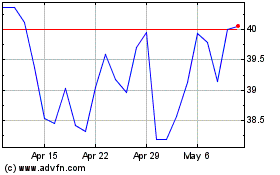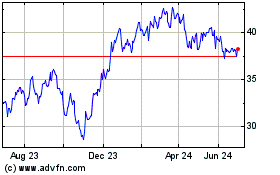By Peter Grant
Some prominent real-estate investors are reducing their holdings
and getting more selective about new deals, in a sign that the
eight-year bull market for U.S. commercial property is coming to a
close.
Asset managers at pension funds and endowments, as well as
private-equity firms and other big investors, are throttling back
on new acquisitions, selling more assets and shifting to less risky
strategies as a way to protect against potential losses in a
downturn.
Additional selling could put stress on the market because demand
for property has started to flag, especially at current price
levels. Deal volume decreased by $58.3 billion, or 11%, in 2016,
the first annual decrease since 2009, according to data firm Real
Capital Analytics, a sign that investor appetite is waning.
Investors that have picked up the pace of selling to lock in
profits include private-equity firm Blackstone Group LP,
real-estate giant Brookfield Asset Management, United Parcel
Service Inc.'s pension trust and Harvard Management Company, which
manages Harvard University's endowment.
When these big investors do buy, they are focusing more on niche
properties such as self-storage warehouses and biomedical
facilities, which haven't seen the sharp price rise of trophy
office buildings and rental apartments.
"We definitely have a risk-off mentality," said Judy McMahan, a
portfolio manager for UPS's $32 billion pension trust. "We're being
careful." The pension trust sold more property than it bought last
year, and its new acquisitions included senior housing and
industrial space in the U.K., said Ms. McMahan.
Brookfield also increased the pace of its selling, unloading
about $3 billion in property in 2016 compared with about half that
much in 2015. The company recently put on the block a 49% stake in
its sprawling Brookfield Place complex in Manhattan. The complex
just finished overhauling its retail space and filling the 2.5
million square feet of office space emptied in 2013 when Bank of
America Corp. moved out.
"We think now is an opportune time to reduce some of our
exposure to that asset," said Brian Kingston, Brookfield senior
managing partner. "We can recycle the capital into higher returning
investment opportunities."
Caution among investors in the $11 trillion U.S. commercial
property sector is being driven by lofty prices, the length of the
market cycle so far and the recent rise in interest rates, which
makes bonds look more attractive compared with commercial property.
Also, developers are adding new supply of some property types at
the fastest rate since the recovery began.
Few investors predict a crash along the lines of the 2008
downturn because debt levels aren't nearly as high and the economy
continues to show signs of strength. Some believe office buildings,
malls, apartment buildings and other commercial property will
continue to enjoy rising rents and occupancy rates if President
Donald Trump's pro-growth economic plans work as intended.
Since 2009, investors have been handsomely rewarded for
purchases of office buildings, warehouses, apartment buildings and
other commercial property. Thanks to low interest rates and the
improving U.S. economy, a valuation index published by Green Street
Advisors has increased 107% since hitting its crash-era low in May
2009. But that rocketing growth is slowing. The Green Street index,
which focuses on top-quality U.S. property owned by real-estate
investment trusts, has stayed flat since mid-2016, according to
Green Street.
Another closely followed metric -- an index compiled by the
National Council of Real Estate Investment Fiduciaries -- showed
total returns from commercial real estate rising 9.2% in the year
ending Sept. 30, 2016, a sharp decline from 13.5% for the 12 months
ending in the third quarter of 2015 and growth ranging from 11% to
14% in each of the previous five years.
Fund investors are pulling back as well. Quarterly distributions
and redemptions from open-ended funds that buy low-risk properties,
a popular investment vehicle among institutional investors, doubled
during the first nine months of 2016, after ticking up just 11% in
2015, according to the council.
Much of the bull market has been fueled by low interest rates,
which encouraged investors to forsake bonds and stretch for more
yield. But rates have jumped since Election Day. Real-estate
investment trusts took the first hit, with equity REITs declining
2.9% in the fourth quarter of last year compared with a gain of
5.3% for the S&P 500, according to Green Street.
So far this year, equity REITs have had a total return of only
0.38%, compared with 1.9% for the S&P 500, Green Street
said.
Also, until recently, the rise in property values was fueled by
developers keeping new supply in check. But that, too, is beginning
to change with certain property types. For example, more than
378,000 new apartments are expected to be completed across the
country this year, almost 35% more than the 20-year average,
according to real-estate tracker Axiometrics Inc.
Private investors say the real estate they are chasing these
days often is either real estate that's less risky or properties
that can be improved and sold quickly, rather than those -- like
developments -- that might not be finished until the economy is
well into the next down cycle.
For example, private-equity giant KKR & Co. moved quickly to
find a buyer last year after it purchased the landmark Sullivan
Center in the Chicago Loop for $267 million. A few months after the
deal closed, KKR sold the retail portion of the 946,000-square-foot
building to Acadia Realty Trust.
"Given we are in the later stage of the real-estate cycle, we
have been focused on business plans that require less time to
create value," said Chris Lee, chair of KKR's real-estate valuation
committee.
Blackstone sold more property than it bought last year,
according to Kenneth Caplan, the firm's chief investment officer
for real estate. Sales have included more traditional property
types such as apartment buildings and hotels. One of its biggest
buys last year was BioMed Realty Trust Inc., which leases offices
to the life science industry. "It's later in the cycle where you
have to be more targeted," Mr. Caplan said.
Harvard's endowment is among the big institutions that sold more
property last year than it purchased, according to people familiar
with the matter. A spokeswoman for the endowment declined to
comment.
Institutions that sell property acknowledge values could keep
rising, but said they want to play it safe.
"Some of the investments we disposed of, if we held on to them
another year or so, it's possible we'd make more money," said Ms.
McMahan of UPS. "However, we felt it was the appropriate time to
monetize our gains."
Write to Peter Grant at peter.grant@wsj.com
(END) Dow Jones Newswires
February 07, 2017 05:44 ET (10:44 GMT)
Copyright (c) 2017 Dow Jones & Company, Inc.
Brookfield Asset Managem... (NYSE:BAM)
Historical Stock Chart
From Mar 2024 to Apr 2024

Brookfield Asset Managem... (NYSE:BAM)
Historical Stock Chart
From Apr 2023 to Apr 2024
